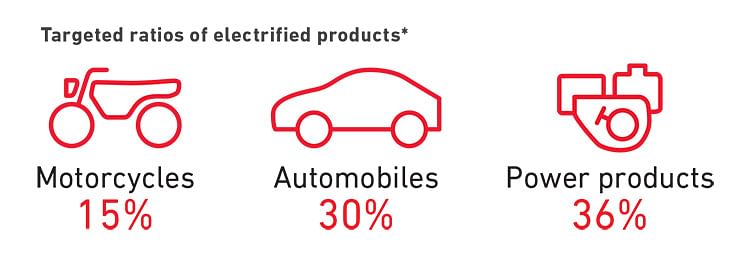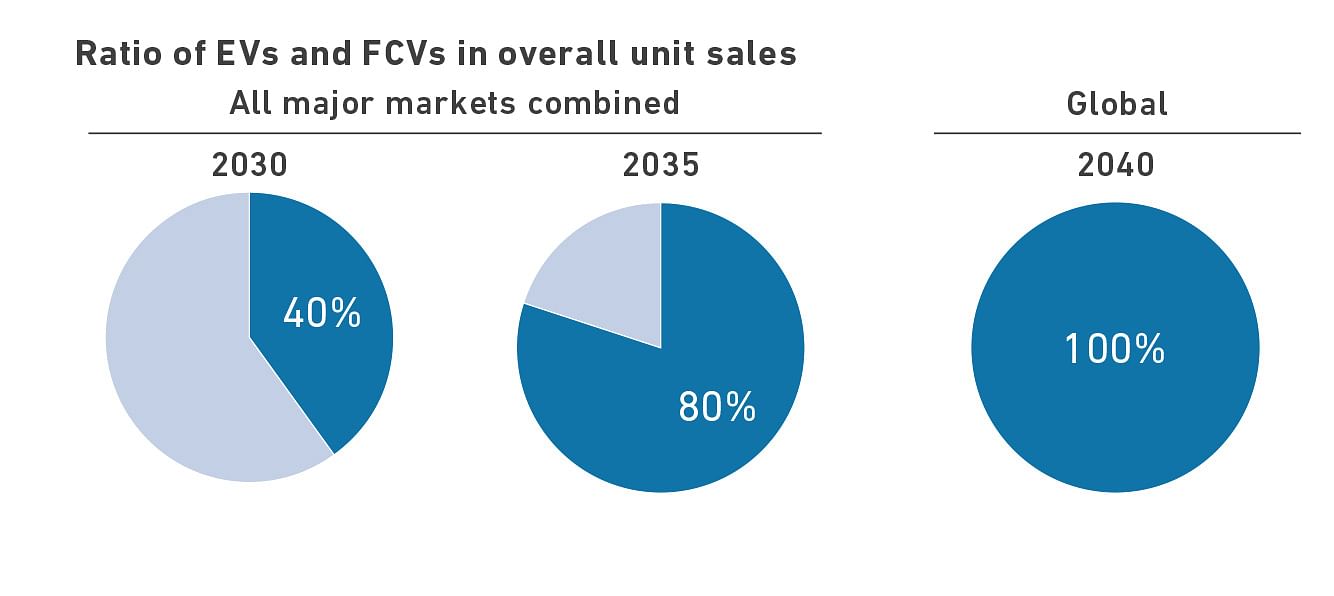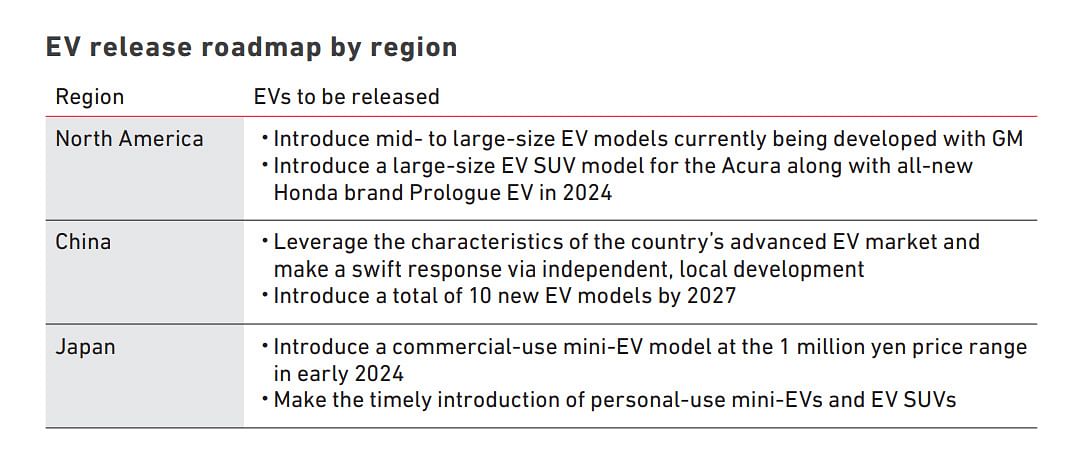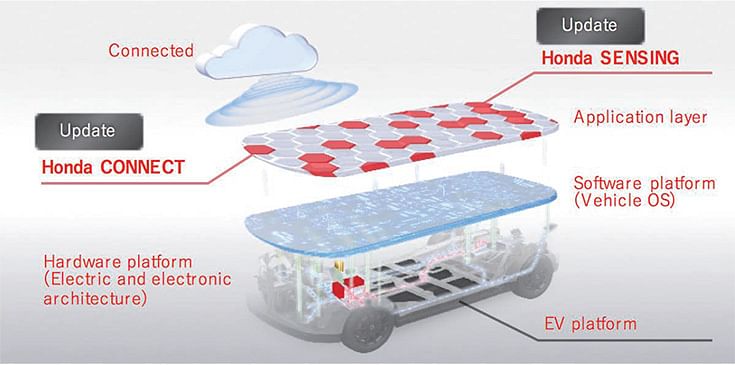Honda to electrify 15% of motorcycles, 30% of automobiles by 2030
Honda to advance powertrain electrification in line with goal to increase the ratio of EVs and FCVs in overall sales in all major markets combined to 40% by 2030, 80% by 2035 and then 100% globally by 2040.
Honda Motor Co today released the ‘Honda Sustainability Report 2022’ which comprehensively summarises Honda’s approach to sustainability and initiatives toward the realization of the Honda 2030 Vision to serve people worldwide with the ‘joy of expanding their life’s potential’, from the perspective of ESG (Environment, Social and Governance).
Advancing powertrain electrification is among the many eco-friendly measures and initiatives the Japanese automaker is taking. Increasing the line-up and use of electrified products will contribute to reducing CO2 emissions when in use, which in turn will lead to lower climate changes risks, while addressing energy issues by making use of renewable energy. In addition, the battery mounted on electrified vehicles can be used as a power source for leisure activities or during an emergency, thereby improving the quality of customers’ lives.

Based on this belief, Honda has set a target to electrify 15% of motorcycles, 30% of automobiles and 36% of power products in their respective global sales in 2030. To achieve this goal, the company is seizing all new business opportunities by enhancing and upgrading its product line-up.
In October 2021, Honda announced that after 2030, it will not release any new gasoline-powered models in China and that all new models coming to the market will be electrified vehicles, such as hybrid vehicles and electric vehicles (EVs). Over the course of five years, Honda will release 10 e:N series models, which represent the first Honda-brand EVs to be released in China. The company also envisions to export these models from China in the future

Strategy for vehicle electrification
With “elimination of our environmental impact” as an overarching theme, Honda says it “is aiming to achieve carbon neutrality by 2050.” Accordingly, it is working to increase the ratio of electric vehicles (EVs) and fuel cell vehicles (FCVs) in overall unit sales in all major markets combined to 40% by 2030, 80% by 2035 and then 100% globally by 2040.
Battery Procurement Strategy
The key challenge in the EV era is the global procurement of batteries. Honda’s basic approach to this challenge is to procure batteries from external partners at the moment and to accelerate independent research and development in the future.
For the procurement of liquid lithium-ion batteries needed now and for the time being, Honda has set respective procurement policies for each of the major markets, based on its commitment to “build EV batteries close to the vehicle production site” in order to maintain its competitiveness from the perspective of the product life cycle as well. Honda aims to secure a stable procurement volume by strengthening external partnerships.
Initiatives for All-Solid-State Batteries
Honda will accelerate its independent research and development of all-solid state batteries, aiming for their realisation in the second half of the 2020s. Currently, Honda is conducting technology and production verification at its lab to determine the batteries’ target performance. Additionally, to ensure performance at the mass production level and verify superiority in terms of cost and safety, the Company has decided to build a demonstration line in Sakura City, Tochigi Prefecture, which will enable product design encompassing production processes. The plan is to invest approximately 43 billion yen (Rs 2,494 crore) and make it operational in spring 2024.
Honda is accelerating research and development with a goal to adopt these batteries to models to be introduced to the market in the second half of the 2020s. Nonetheless, mass production of these batteries is a challenge even for Honda. The Company will make proactive efforts to strengthen the required structure in the future, including securing more human resources with specialized knowledge.

Roadmap for EV releases
During the early stage of proliferating EVs (at present to the latter half of the 2020s), Honda will release products matched to the respective characteristics of major markets such as North America, China and Japan. In realizing the more widespread use of EVs (from the latter half of the 2020s onwards), the Company will evolve its strategy from introducing the “best EVs matched to each region” to releasing the “best EVs from a global perspective.
Honda e: Architecture Platform for EVs
In 2026, Honda will begin adopting the Honda e: Architecture, a new EV platform that combines hardware and software platforms of EVs. More specifically, it combines an EV’s hardware platform, including batteries, with a next-generation electronic platform serving as a foundation for over-the-air (OTA) technology necessary for updating vehicles’ functions later.

By blending hardware and software, Honda will be able to stay connected with its customers after product sales and provide various services and values. The Company intends to offer added value only Honda can provide to its customers by applying the platform beyond automobiles to other types of mobility products in the future.
Meanwhile, through an alliance with GM, Honda is planning to introduce affordable EVs in 2027, with a cost and driving range that will be as competitive as gasoline-powered vehicles. Under the joint development, Honda will continue to work to expand the foundation for the widespread use of EVs globally, including extending its efforts to joint procurement
30 EVs globally by 2030
By 2030, Honda is planning to launch 30 EV models globally, with a full line-up from commercial-use mini-EVs to flagship-class models, and achieve annual production volume of more than 2 million units.
As a production structure to sustain the volume, Honda is planning to build a dedicated EV production plant in Wuhan and Guangzhou, China, and a dedicated EV production line in North America. Honda is committed to “sourcing and manufacturing products close to the market” from the perspective of the product life cycle. As this strategy will in turn generate competitiveness, the Company will examine the required production capacity for each of the major markets in a timely manner.
All data charts courtesy 'Honda Sustainability Report 2022'
RELATED ARTICLES
Skoda begins sale of made-in-India CKD Kushaq in Vietnam
Before production started, pre-series Kushaq vehicles covered over 330,000 kilometres on a variety of Vietnamese roads a...
Six Japanese companies join forces to expand use of recycled materials in new vehicles
Denso, Toray Industries, Nomura Research Institute, Honda Motor, Matec Inc and Rever Corporation have set up the BlueReb...
BYD selects Voestalpine as steel supplier for its Hungarian plant
The announcement of the Austrian steelmaker as a supplier demonstrates BYD’s strategic plan to source from high-quality,...





 By Autocar Professional Bureau
By Autocar Professional Bureau
 29 Jun 2022
29 Jun 2022
 6071 Views
6071 Views









